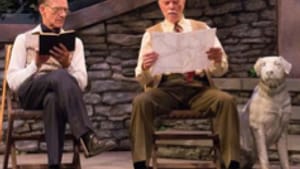Stay in the Loop
BSR publishes on a weekly schedule, with an email newsletter every Wednesday and Thursday morning. There’s no paywall, and subscribing is always free.
Is old age really so dreadful?
Stoppard's "Heroes' at the Lantern (3rd comment)

A rousing military fanfare gives way to the insistent melancholy of honking geese, and three World War I soldiers survey their final domain: the terrace of their Catholic veterans' "sanatorium" in 1959.
Having survived the Great War with a variety of wounds— visible and invisible— Philippe, Henri and Gustave now brave militant nuns, the terror of slippery moss and the problem of birthdays.
"Is there to be no end for the mania for celebrating birthdays?" the cantankerous Gustave complains in Tom Stoppard's Heroes, currently at the Lantern Theatre. (Modern social media users may relate to this lament in an age when 30-somethings celebrate their "birthday week" with a string of happy hours, parties and brunches.)
In stories like Heroes, geriatric protagonists plot strategies to flee the nursing home, or at least to relive their glory days however they can. Such works are based on the common assumption that nobody really wants to live in a retirement home. It's a place where the parameters of life, as Gustave grimly recites them, are "Room, terrace, tepid soup, beddy-bye."
"They cannot shake their past," director M. Craig Getting writes in the Lantern Theater's playbill, "so instead they relive it— however and whenever possible. Yet reminiscing can go only so far." Eventually, Getting suggests, they must try to escape "the mundanities of the veterans' home."
This sounds like a good premise for a poignant drama. But the less theatrical reality I have observed— at a real Christian home full of real veterans— is that old folks are very capable of living happily in the moment.
Perks at Applebee's
My widowed 88-year-old grandfather, a World War II vet, lives in Cairnwood Village, a small religious complex of senior citizens' apartments outside Philadelphia whose residents seem to be celebrating someone's 90th birthday every other week. They live so long, I suspect, because they're all having such a great time.
Grampa still has his Purple Heart, from a shrapnel wound on his back. But he rarely mentions it now— except when he insists on parking in the handicapped space at Applebee's. "I'm a wounded veteran," he'll explain on such occasions.
My own Granny's 90th birthday is next on the calendar. She and Papa— my other grandfather, a veteran of the Pacific theater in World War II— live just a few doors down from Grampa and across the hall from Granny's sister, my Aunt Helga. Papa's brother, my Uncle Bob, lives on the other side of the building. And until a few years ago, Grampa's sisters, Aunt Doreen, Aunt Joyce and Aunt Tiny, all lived in a wing that was unofficially named for their family.
Escape from the hospice
I'm told that Aunt Doreen, who died less than two years ago (a few days shy of her 92nd birthday), said that the happiest moment of her whole life was the morning she had breakfast with her brothers after they all returned safely from the European battlefields of World War II. Many years later, they came to live right down the hall from her.
When she seemed to enter her final decline a few years ago, Doreen's nieces moved her to a hospice and notified the family that she had a few months, at most. But Aunt Doreen began to improve and soon found herself back at Cairnwood Village.
Personally, I think she couldn't bear missing the facility's social life: catered community dinners on Tuesday and Thursday nights, tea with the local clergy, doctrinal class, weekly Bingo, daily puzzles in the lounge, birthday parties and equally convivial funeral dinners, church services streamed right into the dining room, and wall-to-wall card games. In her final year, in the rare moments when she didn't have visitors, Aunt Doreen was transfixed by the bird documentaries I streamed for her on my iPad— "that magic box of yours," she called it.
Ice cream with friends
Doreen did share one common characteristic with Stoppard's Henri, Gustave and Philippe: Had she wanted to escape, she wouldn't have done it alone.
One spring afternoon, when I asked her if she'd like to go out for ice cream, her eyes lit up and she grabbed the phone.
"Can we ask Marg, too?" she said, and called her friend up the hall.
We drove to Rita's, and I took the scenic route home. Marg and Doreen exclaimed over the trees and flowers, and returned to Cairnwood Village totally content.
Grampa's cocktail parties
Granted, I haven't yet reached my 30th birthday. But it seems to me that old age, like any other phase of life, is what you make of it— even for war veterans.
Until recently, my Grampa hosted cocktail parties in his apartment almost every day at 5 p.m., serving crackers and cream cheese with red pepper jelly and generous shots of Seagram's on the rocks. When I attended, his friend Jim, after greeting me, always told me the same story about a fiery Puerto Rican woman named Alaina, who once bested a police officer with a Kleenex.
Unlike Stoppard's trio, none of these geriatric guests would want to be anywhere else.♦
To read another review by Marshall A. Ledger, click here.
To read another review by Jake Blumgart, click here.
To read a response, click here.
Having survived the Great War with a variety of wounds— visible and invisible— Philippe, Henri and Gustave now brave militant nuns, the terror of slippery moss and the problem of birthdays.
"Is there to be no end for the mania for celebrating birthdays?" the cantankerous Gustave complains in Tom Stoppard's Heroes, currently at the Lantern Theatre. (Modern social media users may relate to this lament in an age when 30-somethings celebrate their "birthday week" with a string of happy hours, parties and brunches.)
In stories like Heroes, geriatric protagonists plot strategies to flee the nursing home, or at least to relive their glory days however they can. Such works are based on the common assumption that nobody really wants to live in a retirement home. It's a place where the parameters of life, as Gustave grimly recites them, are "Room, terrace, tepid soup, beddy-bye."
"They cannot shake their past," director M. Craig Getting writes in the Lantern Theater's playbill, "so instead they relive it— however and whenever possible. Yet reminiscing can go only so far." Eventually, Getting suggests, they must try to escape "the mundanities of the veterans' home."
This sounds like a good premise for a poignant drama. But the less theatrical reality I have observed— at a real Christian home full of real veterans— is that old folks are very capable of living happily in the moment.
Perks at Applebee's
My widowed 88-year-old grandfather, a World War II vet, lives in Cairnwood Village, a small religious complex of senior citizens' apartments outside Philadelphia whose residents seem to be celebrating someone's 90th birthday every other week. They live so long, I suspect, because they're all having such a great time.
Grampa still has his Purple Heart, from a shrapnel wound on his back. But he rarely mentions it now— except when he insists on parking in the handicapped space at Applebee's. "I'm a wounded veteran," he'll explain on such occasions.
My own Granny's 90th birthday is next on the calendar. She and Papa— my other grandfather, a veteran of the Pacific theater in World War II— live just a few doors down from Grampa and across the hall from Granny's sister, my Aunt Helga. Papa's brother, my Uncle Bob, lives on the other side of the building. And until a few years ago, Grampa's sisters, Aunt Doreen, Aunt Joyce and Aunt Tiny, all lived in a wing that was unofficially named for their family.
Escape from the hospice
I'm told that Aunt Doreen, who died less than two years ago (a few days shy of her 92nd birthday), said that the happiest moment of her whole life was the morning she had breakfast with her brothers after they all returned safely from the European battlefields of World War II. Many years later, they came to live right down the hall from her.
When she seemed to enter her final decline a few years ago, Doreen's nieces moved her to a hospice and notified the family that she had a few months, at most. But Aunt Doreen began to improve and soon found herself back at Cairnwood Village.
Personally, I think she couldn't bear missing the facility's social life: catered community dinners on Tuesday and Thursday nights, tea with the local clergy, doctrinal class, weekly Bingo, daily puzzles in the lounge, birthday parties and equally convivial funeral dinners, church services streamed right into the dining room, and wall-to-wall card games. In her final year, in the rare moments when she didn't have visitors, Aunt Doreen was transfixed by the bird documentaries I streamed for her on my iPad— "that magic box of yours," she called it.
Ice cream with friends
Doreen did share one common characteristic with Stoppard's Henri, Gustave and Philippe: Had she wanted to escape, she wouldn't have done it alone.
One spring afternoon, when I asked her if she'd like to go out for ice cream, her eyes lit up and she grabbed the phone.
"Can we ask Marg, too?" she said, and called her friend up the hall.
We drove to Rita's, and I took the scenic route home. Marg and Doreen exclaimed over the trees and flowers, and returned to Cairnwood Village totally content.
Grampa's cocktail parties
Granted, I haven't yet reached my 30th birthday. But it seems to me that old age, like any other phase of life, is what you make of it— even for war veterans.
Until recently, my Grampa hosted cocktail parties in his apartment almost every day at 5 p.m., serving crackers and cream cheese with red pepper jelly and generous shots of Seagram's on the rocks. When I attended, his friend Jim, after greeting me, always told me the same story about a fiery Puerto Rican woman named Alaina, who once bested a police officer with a Kleenex.
Unlike Stoppard's trio, none of these geriatric guests would want to be anywhere else.♦
To read another review by Marshall A. Ledger, click here.
To read another review by Jake Blumgart, click here.
To read a response, click here.
What, When, Where
Heroes. By Tom Stoppard, adapted from Le Vent des Peupliers, by Gérald Sibleyras; M. Craig Getting directed. Lantern Theater production through June 16, 2013 at St. Stephen’s Theatre, 923 Ludlow St. (215) 829-0395 or www.lanterntheater.org.
Sign up for our newsletter
All of the week's new articles, all in one place. Sign up for the free weekly BSR newsletters, and don't miss a conversation.

 Alaina Johns
Alaina Johns